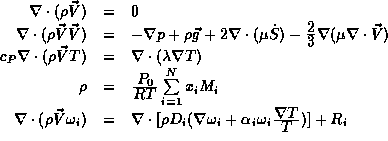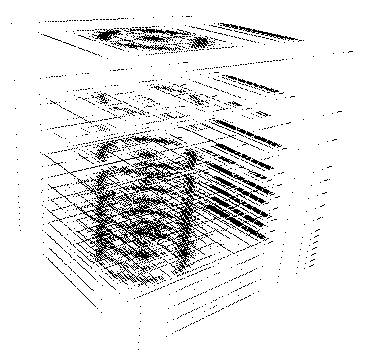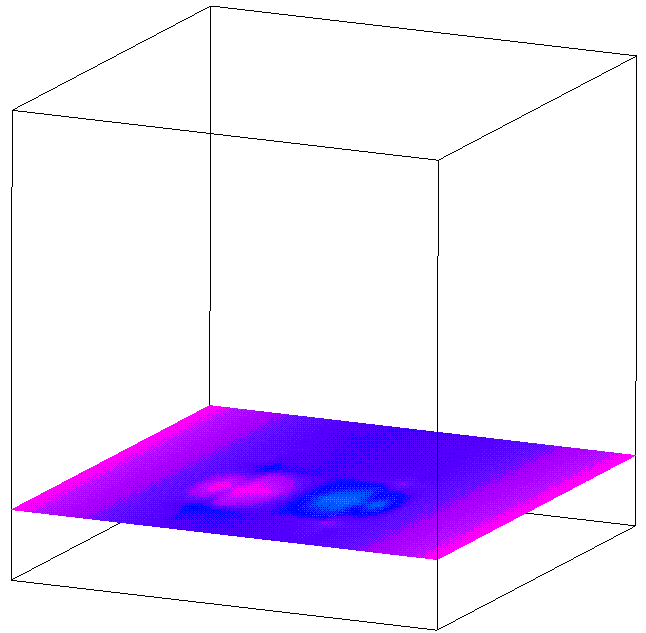|
Description
|
This BMBF-Project is a collaboration of
the
University of Erlangen-Nürnberg (Prof. Dr. Dr. h.c. F. Durst, Institute
of Fluid Mechanics, Technical Faculty),
the University of Bonn
(Prof. Dr. Michael Griebel , Department of Applied Mathematics, Division for
Scientific Computing and Numerical Simulation), the
Technical University of
Munich (Prof. Dr. A. Bode, LRR, Department of Informatics) and
AIXTRON AG in Aachen.
The aim of this project is the develoment of mathematical models,
efficient numerical techniques and modern software tools for the
study and optimization of the growth of layers of compound semiconductor
of AlxGa1-xAs, GaxIn1-xP
and InxGa1-xN obtained by MOVPE (Metalorganic
Vapor Phase Epitaxy). MOVPE is a special kind of CVD where
single crystal thin films of compound semiconductor layers with metal
organic compounds as basic ingrediences are produced. Fields of applications
of this technique are, e.g., the production of microelectronic and
opto-electronic components which are based on III-V-semiconductor
layers such as GaAs or InP (Recently, the development of blue light
emitting LED's and blue lasers using MOVPE based on (Al,Ga,In)N rose
interest amongst experts on this field). For a more detailed introduction
in this topic compare [3], [4]
[9] and [10].
There exists some different types of CVD reactor which are different
in their behaviour concerning fluid flow and chemical reactions.
Widespread in the application of MOVPE and also the subject of this
BMBF-project are linear horizontal reactors and radial symmetric,
horizontal multiwaver reactors such as the AIX 2400/2600G3. A rough
sketch of these types of reactors can be found in Figure 1.

Figure 1: types of reactors for MOVPE: (a) linear horizontal reactor,
(b) radial symmetric, horizontal multiwaver reactor (compare also
[4])
From a mathematical point of view we have to deal with laminar fluid
flow of a chemically reacting mixture of gas with strongly coupled
natural and enforced convection. Here, we face low Reynold numbers
(about 1-100), low Mach numbers (about 10,-2), average to
high Rayleigh numbers (about 102 to 105) and
high temperature gradients. The equations of interest are the
unsteady Navier Stokes equations together with equations for the
chemical compounds (compare [1], [4]
and [9]):

Standard discretizations of the above equations normally use full
grids where the total number of grid points is of the order
O(h3). Exploiting the benefits of sparse grids leads
to grids that possess O(h (log h-1)2) grid
points and hence have substantially less grid points compared to
full grids. Nevertheless, the accuracies on sparse and full grids
measured in different norms are compareable (for a more detailed
desription, compare those Related Projects that deal with
Finite Differences on Sparse Grids at the bottom of this page).
To study the impact of the rotation of the susceptor within
numerical simulations we focused the following problem: fluid
was flowing through a linear horizontal CVD reactor and was
heated from below. Due to the rotation of the susceptor there
are jumps in the boundary condition for the velocities. Due to
the rotation a non-symmetric temperature distribution as well
as non-symmetric velocities are obtained. Within the numerical
simulation the jumps of the velocities have to be resolved
which can be done either by a kind of deformed full grid or
adaptivity. In our example, we use adaptively refined sparse
grids. A rough sketch of the CVD reactor with the domain of
interest as well as the used adaptive sparse grid can be seen
in Figures 2 and 3.

Figure 2: sketch of the CVD reactor

Figure 3: adaptive sparse grid of the purple marked region of the CVD reactor
In Figure 4 the temperature distribution 20% above the susceptor can be
seen. Moreover, Figure 5 shows the impact of the rotation of the susceptor
to the u-velocity which is the velocity in the main direction of the fluid
flow.

Figure 4: temperature distribution 20% above the susceptor

Figure 5: impact of the rotation of the susceptor to the u-velocity
| Bibliography
|
- [1] R. B. Bird, W. E. Steward and E. N. Lightfood,
Transport phenomena,
John Wiley & Sons, New York, 1960
- [2] A. J. Chorin ,
Numerical Solution of the Navier Stokes Equations,
J. Math. Comput., Vol. 22, pp 745-762, 1968
- [3] M. Dauelsberg ,
Entwicklung mathematischer Modelle und numerische Simulation der MOCVD
von Verbindungshalbleitern,
Diplomarbeit, Lehrstuhl für Strömungsmechanik,
Universität Erlangen-Nürnberg, 1995
- [4] M. Dauelsberg, F. Durst, L. Kadinski, Y. Makarov, G. Strauch,
H. Jürgensen, T. Schiekofer, M. Griebel, A. Bode, P. Luksch and M. May,
PAR-CVD: Entwicklung leistungsfähiger paralleler Berechnungsverfahren zur
Untersuchung und Optimierung von CVD-Prozessen,
in Proceedings der BMWF-Tagung HPSC97, München, 1997
- [5] J. H. Ferzinger and M. Peric,
Computational Methods for Fluid Dynamics,
Springer, Berlin/Heidelberg 1996
- [6] P. M. Gresho and R. L. Sani,
On Pressure Boundary Conditions for the Incompressible Navier-Stokes-Equations,
International Journal for Numerical Methods in Fluids, also: Lawrence
Livermore National Laberatory, Preprint UCRL-96471
- [7] M.Griebel, ,
Adaptive sparse grid multilevel methods for elliptic PDEs based on finite differences,
Computing, 1998
- [8] M.Griebel,
T. Schiekofer
An adaptive sparse grid Navier Stokes solver in 3D based on the finite difference approach,
Proceedings of ENUMATH 97, Wiley, 1998 (to appear)
- [9] L. Kadinski,
Mathematische Modellierung und numerische Simulation von
CVD-Prozessen in der Halbleitertechnik,
Dissertation, Universität Erlangen-Nürnberg, 1996
- [10] C. R. Kleijn,
Chemical Vapor Deposition Processes,
in M. Meyyappen, Computational modelling in semiconductor processing,
Artech House, 1995, chapter 4, pp. 97
- [11] T. Schiekofer,
Die Methode der Finiten Differenzen auf Dünnen Gittern zur adaptiven
Lösung partieller Differentialgleichungen,
Dissertation Universität Bonn, Institut für Angewandte Mathematik,
to appear 1998
- [12] T. Schiekofer and M. May,
An Abstract Data Type for Parallel Simulations based on Sparse Grids,
in Proceedings of the Third European PVM Conference, Munich, Germany,
October 7-9th 1996, Springer Verlag, Lecture Notes in Computer Science,
Vol. 1156, 1997
| | Related projects
|
| |